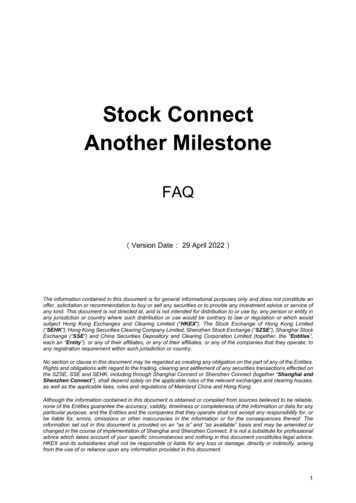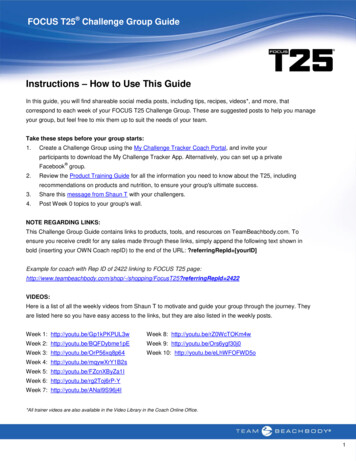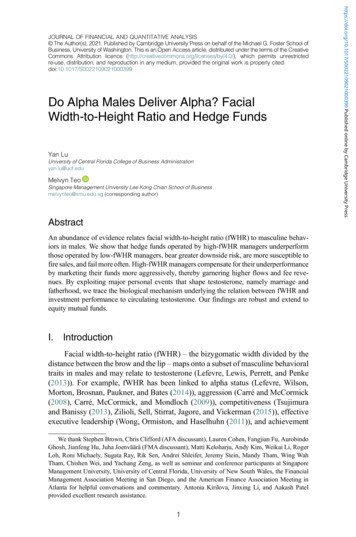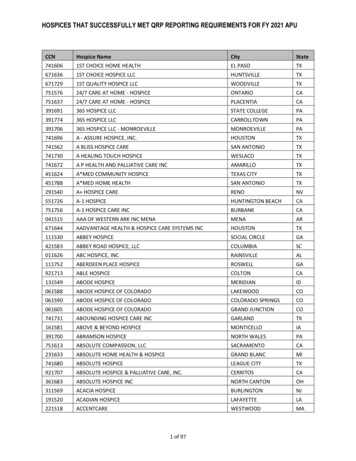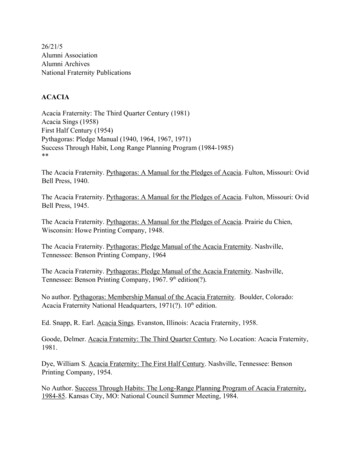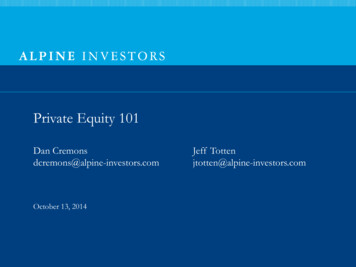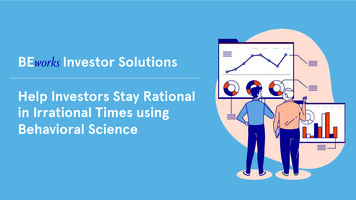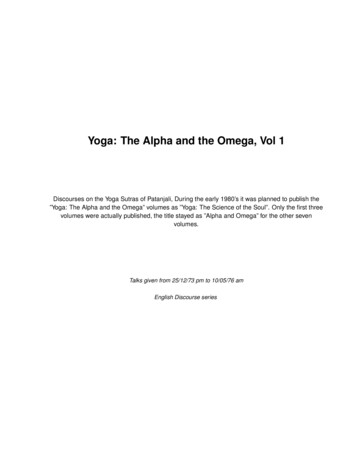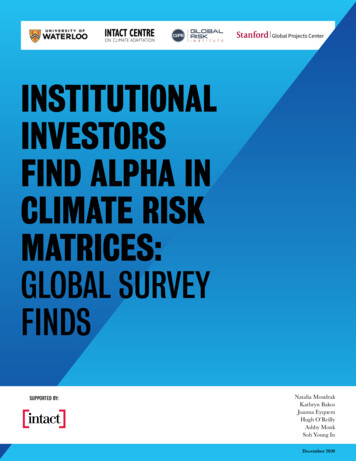
Transcription
Global Projects CenterINSTITUTIONALINVESTORSFIND ALPHA INCLIMATE RISKMATRICES:GLOBAL SURVEYFINDSSUPPORTED BY:Natalia MoudrakKathryn BakosJoanna EyquemHugh O’ReillyAshby MonkSoh Young InDecember 2020
ABOUT THE INTACT CENTRE ON CLIMATE ADAPTATIONThe Intact Centre on Climate Adaptation (Intact Centre)is an applied research centre at the Universityof Waterloo. The Intact Centre was founded in 2015with a gift from Intact Financial Corporation, Canada’slargest property and casualty insurer. The Intact Centrehelps homeowners, communities and businesses toreduce risks associated with climate change and extremeweather events. For additional information, visit:www.intactcentreclimateadaptation.caABOUT THE UNIVERSITY OF WATERLOOThe University of Waterloo is Canada’s top innovationuniversity. With more than 41,000 full and part-timestudents (Fall 2019), the university is home to the world’slargest co-operative education system of its kind.The university’s unmatched entrepreneurial culture,combined with an intensive focus on research, powersone of the top innovation hubs in the world. Foradditional information, visit: www.uwaterloo.caand the U.S. In Canada, Intact distributes insurance underthe Intact Insurance brand through a wide network ofbrokers, including its wholly-owned subsidiary BrokerLink,and directly to consumers through belairdirect. FrankCowan Company, a leading MGA, distributes public entityinsurance programs including risk and claims managementservices in Canada. In the U.S., Intact Insurance SpecialtySolutions provides a range of specialty insurance productsand services through independent agencies, regional andnational brokers, and wholesalers and managing generalagencies. Products are underwritten by the insurancecompany subsidiaries of Intact Insurance Group USA, LLC.ACKNOWLEDGMENTSThe Intact Centre thanks GRI, Stanford Global ProjectsCenter and IFC for their support of the report. We aregrateful to all institutional portfolio managers who offeredsubstantial feedback throughout the “Intergrating ClimateRisk into Institutional Portfolio Management” survey.ABOUT THE GLOBAL RISK INSTITUTECITATIONThe Global Risk Institute is the premier organizationthat defines thought leadership in risk management forthe financial industry globally. It brings together leadersfrom industry, academia, and government to drawactionable insights on emerging risks globally. For moreinformation, visit: https://globalriskinstitute.org/Moudrak, N., Bakos, K., Eyquem, J., O’Reilly, H.,Monk, A., and In, S. Y. 2020. Institutional InvestorsFind Alpha in Climate Risk Matrices: Global SurveyFinds. Prepared by the Intact Centre on ClimateAdaptation, Global Risk Institute and Stanford GlobalProject Center.ABOUT STANFORD GLOBAL PROJECTS CENTERThe Global Projects Center is an interdisciplinaryresearch center at Stanford University. The center seeksto facilitate understanding of the financing, development,and governance of critical infrastructure worldwide. Thecenter conducts interdisciplinary research, facilitatesengagement among academic and industry leaders, andeducates future leaders within the infrastructure financeand development space.ABOUT INTACT FINANCIAL CORPORATIONIntact Financial Corporation (TSX: IFC) is the largestprovider of property and casualty (P&C) insurance inCanada and a leading provider of specialty insurance inNorth America, with over CAD 11 billion in total annualpremiums. The Company has approximately 16,000employees who serve more than five million personal,business and public sector clients through offices in CanadaFor information about this report, contactNatalia Moudrak: nmoudrak@uwaterloo.caDISCLAIMERThe information stated in this report has, to the best of ourknowledge, been collected and verified as much as possible. TheIntact Centre cannot make any guarantees of any kind, as to thecompleteness, accuracy, suitability or reliability of the data providedin the report. This report has been prepared for general guidance onmatters of interest only and does not constitute professional advice.You should not act upon the information contained in this publicationwithout obtaining specific professional advice. No representationor warranty (express or implied) is given as to the accuracy orcompleteness of the information contained in this publication, andIntact Centre employees and affiliates do not accept or assume anyliability, responsibility or duty of care for any consequences to you oranyone else acting, or refraining to act, in reliance on the informationcontained in this report or for any decision based upon it.
TABLE OFCONTENTSAbstractp. 5Introductionp. 7Climate Risk Matrices:A Practical Approach to Integrate Physical Climate Riskinto Portfolio Managementp. 11International Survey:Integrating Climate Risk into InstitutionalPortfolio Managementp. 13Analysis of International Survey Outcomesp. 15Conclusionp. 20Referencesp. 21Institutional Investors Find Alpha In Climate Risk Matrices: Global Survey Finds1
2Institutional Investors Find Alpha In Climate Risk Matrices: Global Survey Finds
“Climate change is a risk, notonly to our environment butto the long-term stability of oureconomy and global financialsystem. Investors need tounderstand the physical andtransition risks climate poses totheir portfolio companies.”Sonia BaxendalePresident and CEO, Global Risk InstituteInstitutional Investors Find Alpha In Climate Risk Matrices: Global Survey Finds3
4Institutional Investors Find Alpha In Climate Risk Matrices: Global Survey Finds
ABSTRACTThe Task Force on Climate-Related Financial Disclosuresadvises that climate change and extreme weather risk shouldfactor into institutional portfolio management, founded onstudies confirming that (1) climate change and extreme weatherrisk are effectively irreversible, and (2) the consequent impacts(largely negative) of climate change could potentially extendacross all business sectors and geographic domains. The need to factor climate risk into portfoliomanagement is clear – the outstanding challenge is“how?” Unfortunately, there is no standardized guidanceregarding means to include physical climate risk intoinstitutional portfolio management.In response, this paper presents Climate Risk Matricesas a practical tool for institutional investors to integratephysical climate risk into portfolio management. In brief,a Climate Risk Matrix identifies the top 1-2 means bywhich extreme weather events (e.g., flood, fire, extremeheat, etc.) may negatively impact a specific industrysector, while identifying actions that a company within thatsector could be expected to take to mitigate these risks.The paper further describes results of an internationalsurvey focused on understanding the methodsInstitutional Investors Find Alpha In Climate Risk Matrices: Global Survey Findsundertaken by portfolio managers to assess physicalclimate risk, the extent of formal training on physicalclimate risk received by the Boards of Directors, C-Suiteofficers and portfolio managers, and the utility ofClimate Risk Matrices to aid portfolio managers ininvestment decisions.The survey results confirm the need to improvetranslation of physical climate risk into financialvaluations, while highlighting the utility of ClimateRisk Matrices as a practical tool, consistent withTCFD, for application of climate risk assessmentinto portfolio management. The survey results alsoillustrate the need for scaling formal training on climaterisk among Boards of Directors, C-Suite officers andportfolio managers.5
6Institutional Investors Find Alpha In Climate Risk Matrices: Global Survey Finds
INTRODUCTIONThe Intergovernmental Panel on Climate Change (IPCC),the United Nations body for assessing climate science, projectsthat global warming is effectively irreversible and thatthere will be an increase in the frequency, intensity andduration of extreme weather events, such as floods,droughts and heat waves, through the 21st century.i, iiDue in part to climate change, the cost of “physicaling international body for the assessmentonment Programme (UNEP) and the Worldnternational assessment of the scientificechnical and socio-economic information, impacts and possible response strategiesrts available on the subject, and form thegovernment and industry worldwide. Thisport, Climate Change 2013/2014. More thanssment Report. The three Working GroupINTERGOV ERNMENTA L PA NEL ONclimate changeclimate risk” (i.e., natural disasters and extreme weatherevents) will continue to rise. Already, 2010-2019 wasthe costliest decade in the modern history ofnatural disasters, with total direct economice IPCCdamages and insured losses tallying 2.98 trillione IPCCk))he IPCCUSD globally, 1.1 trillion USD higher than in thecarried out by the three Working Groups ofrovides an integrated assessment of climateprevious decade iii. Notably, the insurance protectionpmentgap, which is the portion of economic losses not coveredby insurance, was 69% in 2019, leaving governments,businesses and individuals “on the hook” to pay forthe majority of damages and disaster recovery efforts iv.Box 1 illustrates selected climate impacts across directindustry sectors.Institutional Investors Find Alpha In Climate Risk Matrices: Global Survey Finds7
BOX 1. EXAMPLES OF PHYSICAL CLIMATE CHANGE IMPACTS THAT CAN AFFECT ASSET VALUATIONAND PORTFOLIO PERFORMANCE Buildings are increasingly more exposed to damagesand/or destruction by floods, forest fires, and otherextreme weather events (e.g., between 2005 and 2017,increased tidal flooding caused by sea level rise eroded 15.9 billion in relative property values for 28.6million coastal properties in 18 states located in theEast and Gulf Coasts of the US).v Infrastructure services are increasingly impactedby climate-related disruptions (e.g., by 2040, much ofthe continental US is projected to experience warmersummers and tripling of extreme-heat days, leadingto a 6 to 18% increase in spending on residential andcommercial electricity).vi Crop production is impacted by changes toharvests and production costs, affecting price, quantityand quality of farmed products (e.g., the EuropeanEnvironment Agency projects that climate changewill lead to a decrease crop productivity in southernEurope, where yields of non-irrigated crops like wheat,8corn and sugar beet are expected to decrease50% by 2050.). vii Fisheries will be impacted due to changing marineand freshwater conditions, ocean acidification,invasive species, and pests (e.g., cold-water fish habitatin Southern Ontario, Canada is projected to decline67% by 2025; and arctic char populations coulddecline by 40% by 2100).viii Fixed income investments can also be impactedby natural disasters and extreme weather events,leading to municipal, state and sovereign credit ratingdowngrades and plummeting value of debt(e.g., following Hurricane Harvey in 2017, Moody’sdowngraded Port Arthur in Texas, from A1 to A2due to its “weak liquidity position that is exposedto additional financial obligations from the recenthurricane damage, that are above and beyond thecity’s regular scope of operations”). ixInstitutional Investors Find Alpha In Climate Risk Matrices: Global Survey Finds
Recognizing that physical climate risks often translateto material losses, the global financial communityemphasizes the need for climate risk disclosures andintegration into portfolio management. For example: Security commissions began to issue guidancerelative to material climate change risk disclosuresby issuers, pointing to the possibility of mandateddisclosures in the near future. xv, xvi The Task Force on Climate-Related FinancialDisclosures (TCFD), the Sustainability AccountingStandards Board (SASB), and Canada’s ExpertPanel on Sustainable Finance (EPSF) haveinstructed investors of their fiduciary duty to assess,disclose and incorporate climate risk into portfoliomanagement. x, xi, xii Judicial systems have accepted climate change andthe risks it presents as self-evident, uncontroversialand beyond reasonable dispute, so it would be nearlyimpossible for Boards of Directors to dismiss climatechange risk - courts require directors to informthemselves about the material facts, while evaluatingand seeking advice about the information presented tothem. xvii The Network of Central Banks and Supervisorsfor Greening the Financial System (NGFS)noted that climate risks are a source of financial riskthat will affect all agents in the economy (households,businesses, governments) across all industry sectorsand all geographies, and called on central banksto integrate climate risk factors into own portfoliomanagement decisions. xiiiHowever, characterization of physical climate risk isa process that requires in-depth technical knowledgeof potential impacts that vary widely across differentgeographies and sectors. While there are technicalframeworks for assessing climate risks, such asInfrastructure Canada’s Climate Lens approach xviii andthe Public Infrastructure Engineering VulnerabilityCommittee (PIEVC) Protocol, xix climate risk assessmentsare being undertaken in a piece-meal manner.Furthermore, there is no standardized guidanceregarding the practical inclusion of physical climate riskinto institutional portfolio management, on an industryby-industry basis. The International Monetary Fund found thatinvestors are currently falling short on pricing physicalclimate risk and advocated for better climate risksdisclosures and stress testing. xiv“There is no standardized guidanceregarding the practical inclusion ofphysical climate risk into institutionalportfolio management, on anindustry-by-industry basis.”Institutional Investors Find Alpha In Climate Risk Matrices: Global Survey Finds9
10Institutional Investors Find Alpha In Climate Risk Matrices: Global Survey Finds
CLIMATE RISKMATRICES:A PRACTICAL APPROACH TO INTEGRATE PHYSICAL CLIMATERISK INTO PORTFOLIO MANAGEMENTA concept that has been developed to fill the identifiedgap in guidance relating to physical climate risk is thatof sector-specific Climate Risk Matrices (CRMs). xxThese matrices identify top 1 to 2 physical climaterisks that portfolio managers should prioritize as mostmaterial to affect performance of companies within agiven industry sector. These impacts reflect the expertadvice of operations officers or similarly experiencedsubject matter experts within industry sectors –based on their collective experience, these practitionersare best positioned to identify a short list of materialmeans by which flood, drought, wildfire, wind orother hazards may convey risk to companies within aspecific industry sector. For each physical climate riskimpact, a risk mitigation action is suggested withina CRM. Prioritized physical climate risk impacts andrisk mitigation actions presented in CRMs, provide apractical format for portfolio managers, as responsiblefiduciaries, to recognize physical climate risk.CRMs have been developed for two industry sectors –Electricity Transmission & Distribution (T&D) and CommercialReal Estate (CRE). xxi The matrices were designed with thefollowing features in mind:Institutional Investors Find Alpha In Climate Risk Matrices: Global Survey Finds user-friendly (i.e., information in the matrix can beeasily understood by any portfolio manager); scientifically well-informed (based on expertadvice from subject matter experts); predisposed to frequent updating (e.g., every fiveyears) to ensure relevancy of guidance, and available for use almost immediately (i.e., toolsthat require years to develop will be “too little toolate”).The T&D CRM (referenced in the surveydescribed subsequently) is presented in Table 1.11
TABLE 1: CLIMATE RISK MATRIX FOR CANADA’S ELECTRICITY TRANSMISSION ANDDISTRIBUTION SECTORFLOODKey Climate Flood-inducedhigh-waterRisklevels resultImpactsin inadequateelectricalclearances belowlines that arehazardous to thepublicMitigationMeasures12Ensure structuresare tall enoughto ensure safeclearances underforeseeable floodlevels, or thatlines are installedundergroundFIREWIND STORMSICE AND SNOWLOADINGTHAWINGPERMAFROSTFire alongtransmissioncorridors cancause outagesif corridors arenot adequatelycleared of brushVegetation/treebranches can fallonto T&D linescausing outagesT&D lines andstructures cancollapse underheavy ice loadingThawing ofpermafrostcan displacetransmissiontower foundations,causing structuralcollapse andoutagesVegetation/treecontacts withtransmission linescan cause arcing,fires and outagesConduct patrols(visual inspectionof utilityequipment andstructures) in fireprone areasT&D lines can bebrought down bywind forcesClear vegetationalong transmission corridorsInstall visualmonitors to detectice loading beforeice loads build,Install antiboost currentgalloping devices to melt ice (i.e.,on conductors and shorting the line)Clear vegetationensure structuresalong transmission are designed tocorridorswithstand windsModifystructures/designsto readily permitadjustment oftowers when linepatrols identifypermafrost thawdisplacementInstitutional Investors Find Alpha In Climate Risk Matrices: Global Survey Finds
INTERNATIONALSURVEY:Integrating Climate Risk into InstitutionalPortfolio ManagementIn 2019, the Intact Centre on Climate Adaptation, theStanford Global Projects Center and the Global RiskInstitute administered an international survey, titled“Integrating Climate Risk into Institutional PortfolioManagement” to 50 institutional investors. The purposeof the survey was two-fold: first, to assess the degree towhich physical climate risk is currently integrated intoportfolio management and investment analyses, andsecond, to test the practical utility of Climate RiskMatrices in assisting portfolio managers with integratingphysical climate risk into portfolio management.The survey was undertaken between October 1 andOctober 31, 2019. Of the 50 invited institutions, 13Institutional Investors Find Alpha In Climate Risk Matrices: Global Survey Findsparticipated (Table 2), representing just over 2 trillionUSD of assets under management. These institutionscollectively met the following criteria: Assets under management: range in size from“small”/ 7 billion to “large”/ 500 billion; Diversity of fund management organizations/mandates: pension funds, property & casualty andlife & health insurance companies, and universityendowment funds; and Geographic representation: North America,Australia and Europe13
TABLE 2: “INTEGRATING CLIMATE RISK INTO INSTITUTIONAL PORTFOLIO MANAGEMENT”SURVEY, LIST OF PARTICIPATING INSTITUTIONSPARTICIPANTCOUNTRYAssets Under Management( Billion USD)*AIMCoCanada 90.26 as of December 2019AllianceBernstein Holding L.P.USA 631 as of September 2020AustralianSuperAustralia 132.86 as of June 2020BlackRock Asset Management Canada LimitedCanada 144.8 as of November 2019Caisse de dépôt et placement du QuébecCanada 253.08 as of June 2020The Canada Pension Plan Investment BoardCanada 330.14 as of June 2020Intact Investment Management Inc.Canada 16 as of October 2020Ontario Teachers' Pension PlanCanada 155.57 as of June 2020RPMI RailpenUK 39.04 (date unspecified)SLC ManagementCanada 193 as of June 2020UK – Environment Agency Pension FundUK 4.47 as of October 2020University of California (Regents)USA 130 as of June 2020University of Toronto Asset Management CorporationCanada 8.63 as of October 2020Total 2.13 Trillion USDExchange Rates Used (as of November 4, 2020) 1.00 CAD to 0.76 USD, 1.00 Pound to 1.30 USD, 1.00 AUD to 0.73 USD.Survey questions were designed to invite feedbackrelative to three aspects of analysis:1. Existing frameworks for climate riskassessment used by portfolio managers;in helping portfolio managers to integrate physicalclimate risks into their investment conversations anddecisions.3. The utility of Climate Risk Matrices (CRMs)Relative to assessing the utility of CRMs for enhancedportfolio management, survey participants were askedto share feedback on the CRM developed for Canada’sElectricity Transmission and Distribution presentedearlier (Table 1). The survey questions and summary ofresponses are presented in Table 3.14Institutional Investors Find Alpha In Climate Risk Matrices: Global Survey Finds2. The extent of formal climate risk trainingreceived by Board members, C-Suite officers andportfolio managers; and
ANALYSIS OFINTERNATIONALSURVEYOUTCOMESKey takeaways relating to the three areas of analysisare described below.4.1 Existing Frameworks for Climate RiskAssessmentThe survey revealed that while the majority ofrespondents (62%) have not yet translated physicalclimate change impacts into financial valuation of assets,the majority (54%) indicated that they viewed physicalclimate risks as a “very high” or “somewhat high”material issue. Qualitative survey responses pointed totwo key factors impeding financial valuation of assetsfrom the standpoint of physical climate risk:1. Lack of decision-friendly climate data disclosure bythe issuers; and2. Lack of standardized best practices for integratingclimate risk into portfolio management.In relation to these two factors, CRMs offer an eloquentsolution, as they succinctly outline the most materialphysical climate risks and risk mitigation measures thatshould be disclosed by companies within specificindustry sectors.4.2 Formal Training on Climate RiskThe survey indicated that there is a general lack ofInstitutional Investors Find Alpha In Climate Risk Matrices: Global Survey Findsformal training of Board Members, C-suite officers andportfolio managers relating to climate risk, which maycompound the difficulty in integrating physical climaterisk into institutional portfolio management: 46% of survey respondents indicated that either“none” of their Board Members received formaltraining on climate risk, or they were not sure aboutthe extent of climate risk training received by theBoard Members; 23% of survey respondents indicated that their ChiefStrategy Officers received no formal training onclimate risk, and 31% indicated that they were not sureabout the extent of climate risk training received by theChief Strategy Officers; 31% of survey respondents indicated that their ChiefInvestment Officers received no formal training onclimate risk, and 15% indicated that they were not sureabout the extent of climate risk training received by theChief Investment Officers; and 46% of survey respondents indicated that either “none”of their portfolio managers received formal training onclimate risk, or they were not sure about the extent ofclimate risk training received by portfolio managers.15
There is an evident need to scale training on climaterisk among institutional investors to help them meet thedirectives outlined in the Task Force on Climate-RelatedFinancial Disclosures, the Sustainability AccountingStandards Board, and Canada’s Expert Panel onSustainable Finance.with actionable insights into industry-specific physicalclimate risks. The same percentage indicated that thelevel of detail provided relating to the key climate riskswas appropriate. However, most respondents (62%)would welcome greater detail regarding mitigationmeasures.The survey results indicate that development of a suiteof CRMs for a broader range of industry sectorsand geographies would assist institutional investors inappropriately integrating physical climate risk into theirportfolio management.4.3 Utility of Climate Risk MatricesA notable 85% of survey respondents indicated thatCRMs would be useful in providing portfolio managersTABLE 3: “INTEGRATING CLIMATE RISK INTO INSTITUTIONAL PORTFOLIO MANAGEMENT”SURVEY RESULTS, 13 RESPONDENTSSURVEY QUESTIONSRESPONSESPart 1: Existing Frameworks for Climate Risk Assessment1. Has your organization translated climaterisk impacts into financial valuation of assets(e.g., through Ratio Analysis, Discounted CashFlow Analysis, “Rules of Thumb” valuations,Economic Value Added Analysis, OptionsPricing models, etc.)?38%062%204060 Yes2. How much weight does your institution attachto the materiality analysis of climate risks appliedto portfolio management?31%023%20 40 80100No31%6015%80100Very HighSomewhat HighSomewhat LowVery Low3. Has your organization performed a materialityanalysis to determine if any of the followingclimate risk factors may influence the performanceof assets in portfolios?62% 62%54%46%46%31%23%23%23%23%8%FLOOD16SEA LEVEL DROUGHT WILDFIRE WINDSTORM SNOWRISEAND ICELOADEXTREMEHEATHAILPERMAFROST OTHER NONE OFTHAWTHE ABOVEInstitutional Investors Find Alpha In Climate Risk Matrices: Global Survey Finds
SURVEY QUESTIONS4. For climate risk factors deemed to be material,please indicate the broad categories of industrysectors to which portfolio managers in yourorganization apply climate risk assessment.RESPONSES77% 77%54%46% 46% 46%38% 38% 38%31%31%23%0 2040Internal expertise onlyNONE OFTHE ABOVEOTHERHEALTH CARECOMMUNICATIONSERVICES15%60 80100External expertise onlyBoth internal and external expertise6. If your organization utilizes internalexpertise for integrating climate risk into portfoliomanagement, what inputs do you use (indicate allthat LITIES8%5. If your organization integrates climate riskinto portfolio management, what is the source ofexpertise?8%REAL ESTATEENERGY8%None of the above69%62%54%46%38%SELF-REPORTEDINFORMATION BYTHE ISSUERInstitutional Investors Find Alpha In Climate Risk Matrices: Global Survey AREPORTSOTHER17
SURVEY QUESTIONSRESPONSES0 All8. Please indicate whether Chief Strategy Officer within yourorganization has received formal training on climate risk.204060Less than Half46%08%15%38%7. Please indicate how many Board Members within yourorganization have received formal training on climate risk.38%Part 2: Formal Training on Climate Risk 80Unsure31%20 Yes40 100None23%6080Not applicable / Not Sure100 No9. Please indicate whether Chief Investment Officer within yourorganization has received formal training on climate risk.54%015% 31%20 Yes10. Please indicate how many Portfolio Managers within yourorganization have received formal training on climate risk.31%20 All100 No15% 31%4060 801008%92% 204060 Yes1880More than halfLess than halfNone / Not Sure11. Does your organization employ an in-house Climate Scientist,who assists portfolio managers?060Not applicable / Not Sure23%04080100NoInstitutional Investors Find Alpha In Climate Risk Matrices: Global Survey Finds
SURVEY QUESTIONSRESPONSESPart 3: Utility of Climate Risk Matrices12. From the perspective of portfolio management, wouldindustry-specific Climate Risk Matrices, such as the oneillustrated in Table 1, be useful to portfolio management?85%015%2040 Yes13. Relative to “Key Climate Risk Impacts” outlined in ClimateRisk Matrix (first row), please indicate whether the level of detailshould be expanded, kept the same, or reduced?8010080100Not Sure15% 85%014. Relative to “Mitigation Measures” outlined in in ClimateRisk Matrix (second row), please indicate whether the level ofdetail should be expanded, kept the same, or reduced? 2040Expanded 60Kept the same62%0Institutional Investors Find Alpha In Climate Risk Matrices: Global Survey Finds60 38%2040Expanded 6080100Kept the same19
CONCLUSIONAs TCFD admonishes, time is not a luxury forinstitutional investors to integrate physical climaterisks into portfolio management. Climate Risk Matrices(CRMs) offer a practical, accessible and user-friendlymethod to address outstanding challenges.The growing magnitude of extreme weather eventsguarantees to challenge businesses across all industrysectors and geographies, obligating them to mitigate theunrelenting impacts of floods, fires, heat waves, stormsurges and other natural disasters.As the survey highlights, as responsible fiduciaries theneed to account for physical climate risk is appreciatedby institutional investors. However, incorporatingphysical climate change impacts into financial valuationof assets is a challenge exacerbated by a lack of decisionfriendly climate data disclosure by issuers and lack ofstandardized practices to integrate climate risk intoportfolio management.industry associations and standards-setting intuitions), thescaled production of Climate Risk Matrices, acrossall sectors and geographies, could begin today.The expansion of formal climate risk training forBoard members, C-suite officers and portfoliomanagers is required if physical climate risk is to beincorporated into well-informed investment decisionsand conversations with issuers.Climate Risk Matrices offer a practical,accessible and user-friendly method to addressthese outstanding challenges. By combining the skillsets of investors and subject matter experts (for example,These two actions combined will provide a practicalway for institutional investors to transform theirgeneral appreciation of the importance of climate risk,into climate risk-informed financial valuations andinvestment decisions, as advised by the Task Force onClimate-Related Financial Disclosures, the SustainabilityAccounting Standards Board, and Canada’s ExpertPanel on Sustainable Finance.20Institutional Investors Find Alpha In Climate Risk Matrices: Global Survey Finds
REFERENCESBush, E. and Lemmen, D.S., editors (2019): Canada’sChanging Climate Report; Government of Canada, Ottawa,444 pp. s/energy/Climate-change/pdf/CCCR FULLREPORT-ENFINAL.pdfiIPCC (2018): Summary for Policymakers. In: GlobalWarming of 1.5 C. An IPCC Special Report on the impactsof global warming of 1.5 C above pre-industrial levels andrelated global greenhouse gas emission pathways, in thecontext of strengthening the global response to the threatof climate change, sustainable development, and effortsto eradicate poverty. World Meteorological Organization,Geneva, Switzerland, 32 pp. https://w
institutional portfolio management. In response, this paper presents Climate Risk Matrices as a practical tool for institutional investors to integrate physical climate risk into portfolio management. In brief, a Climate Risk Matrix identifies the top 1-2 means by which extreme weather events (e.g., flood, fire, extreme
